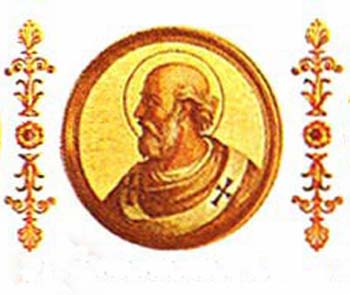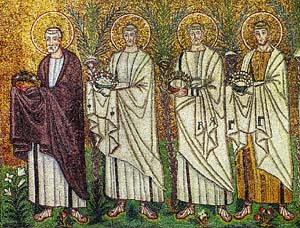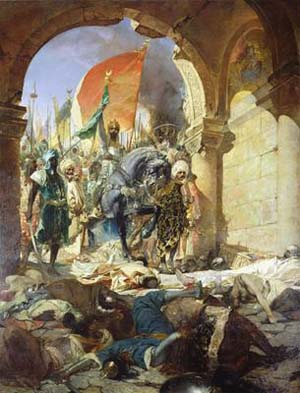 |
The Saint of the Day
Pope St. Martin I – November 12
Prof. Plinio Corrêa de Oliveira
Biographical selection:
St. Martin was named successor of Pope Theodore I in the year 649. The soul of the new Pope had to be great to face the great difficulties of the times. To save the Church in the East, he condemned Monothelism, which claimed Christ had only one will.

Pope St. Martin I, martyr |
Shortly after, Emperor Constans II, who was a Monothelist, ordered his agents to kidnap the Pope. They took Pope Martin and brought him by ship to stand before the Emperor at Constantinople. The Pope suffered enormously during the voyage and arrived in Constantinople very weak. There he was held in a filthy, freezing cell in a prison for three months. Finally, in handcuffs, he was dragged before a tribunal, and under the depositions of false witnesses he was condemned to death as a traitor and heretic. After the sentence was read, he was taken to a terrace of the palace near the imperial stables where a multitude was gathered.
The judge who had presided at the tribunal approached St. Martin and mocked him: “You see how God delivered you into our hands. You were against the Emperor, and thus has God abandoned you.”
Then the soldiers slashed his clothing and took away his shoes. He was delivered to the prefect of the city with the order of execution. The judge tried to incite the populace to anathematize St. Martin, but the mob remained silent gazing at the ground, with the exception of some 20 people who followed the order. After a while, the crowd dispersed.
The soldiers stripped the Pope of his shredded clothes and dressed him in a grotesque tunic, open on both sides, to humiliate him. They put an iron ring around his neck with a rope attached to it, and dragged him to a prison of common criminals. In the freezing cold, St. Martin trembled and awaited death. But at the last moment his death was commuted to life imprisonment.
In Crimea, where he was exiled, his suffering increased daily until the Creator called his soul in 655. Pope Martin left praiseworthy letters, full of wisdom, as well as his answers to the tribunal, written in a noble and sublime style, worthy of the majesty of the Apostolic See.
Comments of Prof. Plinio:
There are various aspects of this martyrdom that are very instructive to us.
First, the extreme respectability of Pope St. Martin and the special form of torment to which he was subjected. He was a saint and, therefore, aware of the supreme dignity of the Pontifical Throne. He knew it was the highest dignity on earth. The dignity of any King or Emperor cannot be compared to the dignity of the Vicar of Christ, to whom Our Lord gave the keys of Heaven and Earth.

The Court of Martyrs: Saints Martin, Clement, Sixtus II, Lawrence - S. Apollinare Nuovo, Ravenna Italy |
Further St. Martin was a man of noble spirit. The selection allows us to see that he was very intelligent and highly educated. His letters reflected a noble and elevated spirit. He loved what is high and sublime.
Second, he was exposed to one of the worst humiliations a Pope had to suffer since the beginning of the Church. We know that St. Peter was crucified, but few Popes suffered a martyrdom as terrible as that of St. Martin. The Roman Pontiff who knew he was the legitimate representative of Our Lord was badly treated during his trip; when he arrived in Constantinople, he was kept in cruel confinement for three months before he was dragged before a court of Monothelist heretics. The tribunal was already prepared to condemn him.
After the condemnation, he was dressed in ridiculous apparel with an iron ring placed on his neck, as if he were an animal to be pulled here and there by a rope at their pleasure. He was mocked by the judge, who far from being an impartial man, instigated the multitude to laugh at and condemn the Sovereign Pontiff. Next, he was dragged barefoot to a prison of common criminals.
We can see the humiliation this represented for a man who respected himself. Further, it was intensely cold and he was trembling. Some bystanders could possibly interpret his trembling as a symptom of fear and have laughed at him. Finally, he was condemned to exile in the Crimea. He died there as a consequence of such bad treatment. For this reason the Church considers him a martyr.
He faced the worst public ordeals, such as the questioning before the Emperor and the judge, with panache and gave the answers that should be given. To the end he did not compromise. It is a noble example of fortitude.
Third, the cruelty of Emperor Constans II and the Monothelist heretics who surrounded him is notable. The Emperor committed an unspeakable crime practiced in the presence of all the people. An Emperor who exposes the Pope to public humiliation commits a sacrilege and brings the curse of God over the Empire. He and his sycophant, the judge, had planned that the people should laugh at the Pope and anathematize him. Even though they were a bad people, they did not do this.
The people remained silent and walked away. If they had been faithful, they would have risen in indignation and liberated the Pope from that outrage. The fact that they did not do this reveals the stage of decadence into which they had fallen.

Turks enter Constantinople on May 29, 1453 - Benjamin Constant, 19th century |
Fourth, this episode also points to the centuries of rivalry that existed between Constantinople and Rome, the two largest cities in the world. This rivalry would lead to the Schism in the 11th century and the establishment of the Schismatic Church, which is called schismatic by a kind of historical condescendence, since it had always been heretical.
I read the report of a witness present in Constantinople when it was taken by the Turks in the 15th century. This man observed that the heretical people of Constantinople were literally terrified by the bloody invasion of the Turks. He noted, however, that if that people were to be given the alternative of returning to the Catholic Faith in order to stop the invasion, they would prefer to continue in the heresy and be destroyed by the Turks. That is, among them there was such a blind hatred toward the truth that nothing else mattered.
We see the fanaticism that the enemies of the Church can have.
How can we explain it? I remember a phrase of Donoso Cortes, a great Spanish thinker. He said that, without the grace of God, men normally like only partial truths; they do not like the whole truth, the universal truth. Normally men hate the whole truth more than anything else.
The Catholic Church offers the total truth. This is why she is hated by so many people. They prefer any error to the whole truth. This explains why those schismatics and heretics of the 15th century hated the Church; this also explains why Modernists, Progressivists, Communists and others hate the universal truth. For this they will be punished by the justice of God.
These are the comments that the edifying martyrdom of Pope St. Martin suggests. Let us ask him to give us his strength and the love for the whole truth.


  | | Prof. Plinio Corrêa de Oliveira | |
The Saint of the Day features highlights from the lives of saints based on comments made by the late Prof. Plinio Corrêa de Oliveira. Following the example of St. John Bosco who used to make similar talks for the boys of his College, each evening it was Prof. Plinio’s custom to make a short commentary on the lives of the next day’s saint in a meeting for youth in order to encourage them in the practice of virtue and love for the Catholic Church. TIA thought that its readers could profit from these valuable commentaries.
The texts of both the biographical data and the comments come from personal notes taken by Atila S. Guimarães from 1964 to 1995. Given the fact that the source is a personal notebook, it is possible that at times the biographic notes transcribed here will not rigorously follow the original text read by Prof. Plinio. The commentaries have also been adapted and translated for TIA’s site.
|
Saint of the Day | Home | Books | CDs | Search | Contact Us | Donate

© 2002- Tradition in Action, Inc. All Rights Reserved
|
 |

|